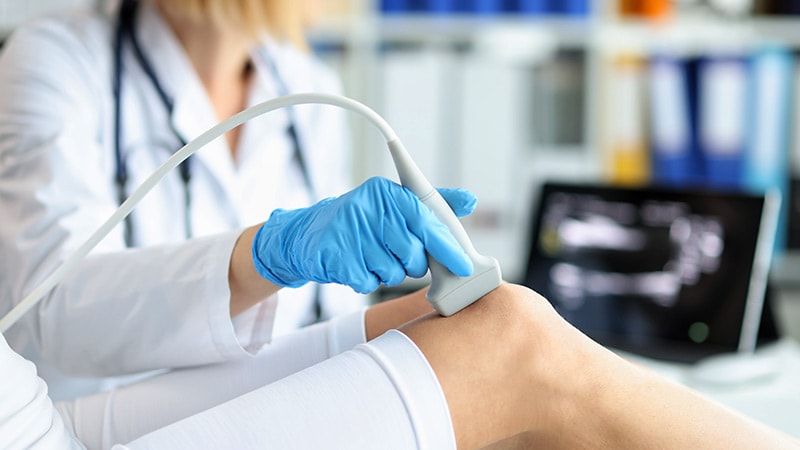BOGOTÁ, Colombia — Early detection and treatment of psoriatic arthritis (PsA) can prevent joint damage and improve long-term disease outcomes. But, to date, no biomarker has emerged that can reliably diagnose early PsA.
At the Group for Research and Assessment of Psoriasis and Psoriatic Arthritis (GRAPPA) 2025 Annual Meeting and Trainee Symposium, researchers presented the latest results from a multiyear international effort to create an ultrasound-based scoring system for enthesitis that can be used to help diagnose early disease.
Enthesitis, or inflammation, in the areas where tendons and ligaments attach to bones is a common feature in PsA and often among the first manifestations of the disease. The Diagnostic Ultrasound Enthesitis Tool (DUET) study, led by Lihi Eder, MD, of the University of Toronto, Toronto, Ontario, Canada, Sibel Aydin, MD, of the University of Ottawa, Ottawa, Ontario, and Gurjit Kaeley, MD, of the University of Florida College of Medicine in Jacksonville, Florida, sought to develop a new sonographic enthesitis scoring system to assist with the diagnosis of PsA.
Eder, who presented the most recent findings from DUET at the conference, described the goal of the study as an ultrasound-based scoring system that can reliably distinguish PsA, scans as few sites as possible, and is reproducible, consistent, and simple to calculate.
Patella, Triceps, and Achilles Tendon Sites Best in Discriminating Conditions
Eder and her colleagues recruited 213 patients with rheumatologist-confirmed PsA (mean, 1.6 years since diagnosis), 100 patients with dermatologist-confirmed psoriasis and no history of PsA, and 106 control patients who had been seen by rheumatologists for noninflammatory musculoskeletal issues. None of the subjects were taking biologic therapies.
The researchers scanned 16 entheseal sites in the upper and lower extremities for each patient. After a preliminary analysis, they chose six sites as the basis for their score and evaluated nearly 50 different combinations of sites. The final DUET score integrated both inflammatory and structural findings from the scanned sites.
DUET scores were significantly higher in people with PsA than in control individuals, regardless of age, sex, and BMI, Eder reported. The patella, triceps, and Achilles tendon were the sites that discriminated best between patients with PsA and control individuals.
While the DUET score had a specificity of over 70%, sensitivity was only about 50% across age groups, meaning that half the patients with early PsA had a negative score. When people presented with one or more tender entheses among the scanned sites, sensitivity rose to 60%.
The sensitivity findings “may be explained by the fact that enthesitis in joints is not seen in all patients with psoriatic arthritis,” Eder said. “It is a heterogeneous disease.”
“We should be aware of the limitation that this tool that does not recognize all patients with PsA,” Eder continued. “But the sensitivity improves when tender entheses are present,” she noted, adding that her group is conducting additional studies to validate DUET in real-world settings.
The DUET study, which has funding from industry, is a GRAPPA-led initiative. GRAPPA co-founder and current president Arthur Kavanaugh, MD, of the University of California, San Diego, said in an interview during the conference that the results were clinically meaningful, even if not as discriminatory as hoped. “In the clinic, you don’t necessarily use ultrasound on people if they’re not tender,” Kavanaugh said.
“I think everyone had wanted a very simple answer, that this [scoring system] was going to be perfect,” he added. “And you saw a very thorough attempt to try and make it so. But the data are the data.”
Philip Mease, MD, of the Swedish Medical Center in Seattle, a GRAPPA co-founder and past president, concurred. The sensitivity numbers “were less than I would have hoped for,” he said. “But that’s the nature of the beast. This is a really difficult thing to assess.”
Mease added that it was helpful for him to learn which scanning sites are the most informative. “This will be very useful for people who do ultrasound as part of their practice,” he said.
The DUET study was sponsored by Lilly, Pfizer, Janssen, Novartis, and AbbVie. Eder disclosed receiving research support and/or consultancy fees from AbbVie, Eli Lilly, Janssen, Novartis, Pfizer, UCB, and Fresenius Kabi. Kavanaugh has consulted for AbbVie, Amgen, Bristol Myers Squibb, Janssen, Novartis, Pfizer, and UCB. Mease disclosed receiving research funding, consulting fees, and/or speaker fees from AbbVie, Amgen, AstraZeneca, Bristol Myers Squibb, Century, Cullinan, Inmagene, Janssen, Eli Lilly, MoonLake, Novartis, Pfizer, Spyre, Takeda, and UCB.
Source link : https://www.medscape.com/viewarticle/ultrasound-based-diagnosis-early-psoriatic-arthritis-remains-2025a1000lai?src=rss
Author :
Publish date : 2025-08-12 08:02:00
Copyright for syndicated content belongs to the linked Source.
